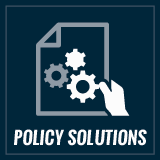
School funding has grown exponentially over the decades, yet college and career readiness remains stubbornly low and there are enormous achievement gaps for low income students. Simply spending more hasn’t – and won’t – help students get the education they deserve and produce a qualified workforce.
Solutions
Education should be student focused, not institution focused
Every child deserves a quality education
Parents know what’s best for their children’s education
Curriculum and other instructional decisions are best made at the local level
Effective teachers have the greatest impact on student performance
Transparency is vital
The system of funding education must be responsible to both the education system and taxpayers
A “one-size-fits-all” approach to educating children does not work
Solutions
- Prepares students for life after school by making them college and/or career ready
- Encourages and recognizes the need for innovative approaches to educating by loosening/waiving regulations that stifle such innovation
- Minimizes intervention of the state and federal governments
- Promotes market-based pay for teachers by
- Recognizing that different teachers/subjects/assignments have different market values
- Rejecting pay systems based on seniority and education levels
- Rewarding effective teachers through a merit pay system
- Addresses ineffective teachers through tenure reform
- Promotes teacher freedom from forced union membership
- Provides for alternative pathways to become a teacher, recognizing that traditional teacher licensure programs are not the only pathway to having a quality instructor in the classroom
- Provides an outcome-based effective finance system that
- Is both adequate and equitable
- Clearly delineates the Legislature as the body responsible for providing funding
- Rewards schools/districts for high performance and allows students to escape chronically underperforming schools
- Requires transparency in spending taxpayer dollars with full disclosure to the public on how money is spent at the building and program level
- Provides easy access to the public on school performance through a school grading system
- Encourages efficient spending through such efforts as
- Cooperative purchasing
- Combining administrative costs
- Unifying teacher benefits
- Allows parental-based school choice
- Expansion of the Tax Credit Scholarship Program
- Changing laws to allow real (independent) charter schools
- Establishing an education spending account (ESA) program that allow parents to make education choices for their children
